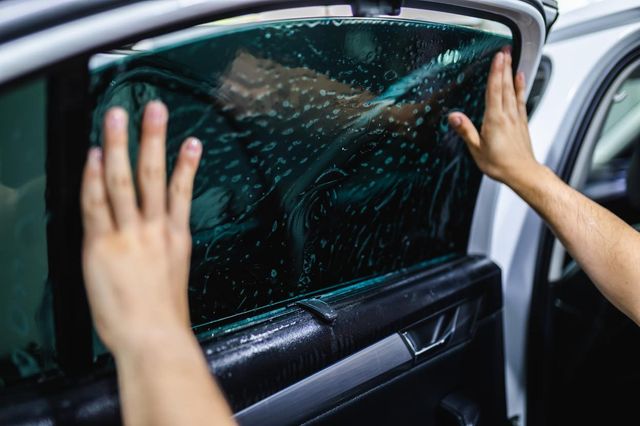Customized Automobile Window Tinting Providers for a Sleek and Trendy Appearance
Customized Automobile Window Tinting Providers for a Sleek and Trendy Appearance
Blog Article
Home Window Tinting Rules and Standards: What You Need to Know Prior To Tinting Your Vehicle
Prior to continuing with home window tinting for your car, it is essential to acquaint on your own with the varied regulations and guidelines that regulate this practice throughout different states. These laws determine the permissible degrees of tint darkness, commonly determined by visible light transmission (VLT) percents, and include details specifications for front windscreens intended at making certain road security.
Summary of Home Window Tinting Regulations
Home window tinting laws are often subject to variation across various jurisdictions, showing regional laws and security considerations. These regulations dictate the acceptable degrees of color darkness and reflectiveness on lorry home windows, making certain that motorists preserve adequate visibility while also securing against dangerous UV rays and warmth.
A lot of policies classify home window tinting based on the Visible Light Transmission (VLT) portion, which shows the quantity of light that can travel through the home window. Generally, reduced VLT percentages represent darker tints. Regulations frequently separate in between the front, side, and back home windows, with more stringent restrictions related to the front windscreen to improve safety and security for both the driver and various other road individuals.
Furthermore, some territories impose constraints on the reflectivity of the tint, avoiding extreme glare that can harm exposure. Exceptions to these laws may exist for people with particular medical conditions requiring additional sunlight defense. Compliance with home window tinting policies is important, as infractions can lead to fines, compulsory removal of the tint, and prospective rises in insurance costs. Therefore, it is important for car owners to familiarize themselves with local regulations before waging home window tinting installments.
State-by-State Color Rules
Recognizing the specific window tinting policies in each state is important for lorry proprietors looking for to follow the legislation. Each state in the U.S. has developed its very own collection of regulations governing home window tinting, which can differ significantly. These policies frequently dictate the allowable degrees of tint darkness, the sorts of windows that can be tinted, and any kind of clinical exceptions that may use.
As an example, states like The golden state have strict limitations on tint darkness for front windows, while others, such as New Mexico, may permit darker colors. In addition, certain states mandate details visibility portions for different home windows, consisting of the windshield, front side windows, and rear windows. It is essential for car proprietors to acquaint themselves with their state's legislations to avoid possible penalties or charges.
Additionally, some states may call for a certification sticker to be positioned on tinted home windows, indicating compliance with state regulations. Failure to comply with these guidelines not just runs the risk of legal effects but can also influence safety and security and exposure while driving. Lorry owners should perform comprehensive study or speak with neighborhood authorities to ensure complete understanding and conformity with state-by-state color laws.
Allowed Tint Degrees and Types
Several lorry owners might be surprised to discover that enabled color levels and kinds differ widely throughout different states. Each state has actually established its own regulations regarding the allowable darkness and reflectivity of window color, frequently measured by Visible Light Transmission (VLT) portions. VLT refers to the amount of light that can pass with the tinted home windows; thus, a lower percent suggests a darker color.

Moreover, the sorts of color products enabled can vary, with some states prohibiting metallic or mirror-like finishes. It is crucial for vehicle owners to familiarize themselves with their state's certain laws to make sure conformity. Non-compliance can lead to fines, obligatory removal of the tint, or various other lawful consequences, making it important to recognize these policies before proceeding with installation.
Medical Exceptions for Tinting
While not all states supply allocations for medical exemptions relating to home window tinting, those that do recognize the requirement for certain individuals to boost presence and convenience due to clinical conditions. Various clinical conditions, such as lupus, skin cancer, and certain eye disorders, can provide go to the website people especially conscious sunshine. These people might call for darker tints to shield themselves from harmful UV rays and glow.

It is very important to note that also with a medical exception, there might still be limitations on the level of color permitted. Compliance with state regulations makes certain that individuals are both secured and within lawful limits. Those taking into consideration clinical exemptions should contact their neighborhood Division of Motor Automobiles or equal authority to recognize the procedures and needs necessary to get an exception successfully.
Penalties for Non-Compliance
Falling short to abide with window tinting laws can bring about substantial fines, which vary by state. Legislation enforcement firms are equipped to release citations for automobiles that do not abide by the specified tinting regulations. These fines generally consist of penalties, which can range from small quantities to numerous hundred dollars, depending upon the seriousness of see here the infraction and the state concerned.
In some territories, repeated offenses might result in rising penalties or added charges, such as mandatory court looks. In addition, non-compliance may require the elimination of illegal tinting, commonly at the owner's expenditure. In severe instances, regular wrongdoers might deal with suspension of their lorry enrollment till compliance is accomplished.
Furthermore, insurance coverage ramifications may develop from receiving numerous citations for home window color violations. Insurance firms may watch such infractions as an indicator of riskier actions, potentially resulting in raised premiums or trouble in protection.
To avoid these fines, it is essential for automobile owners to familiarize themselves with their neighborhood window tinting legislations and make certain that their car complies (Window Tinting). This proactive strategy not only avoids lawful implications however also promotes road safety
Verdict

The majority of laws classify home window tinting based on the Visible Light Transmission (VLT) percent, which suggests the amount of light that can pass through the window. Compliance with home window tinting guidelines is crucial, as violations can result in penalties, obligatory removal of the tint, and potential increases in insurance premiums.Understanding the particular home window tinting regulations in each state is essential for automobile proprietors seeking to abide with the regulation. These guidelines typically dictate the allowable levels of color darkness, the kinds of windows that can be tinted, and any type of medical exemptions that might use.
For instance, states like The golden state have strict restrictions on color darkness for front windows, while others, such as New Mexico, may check it out permit darker tints.
Report this page